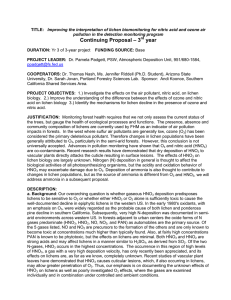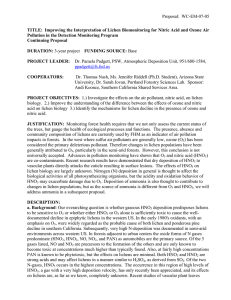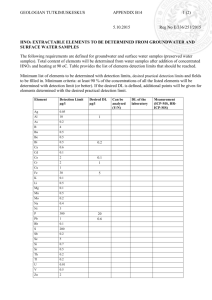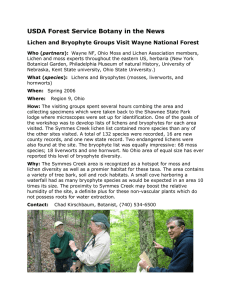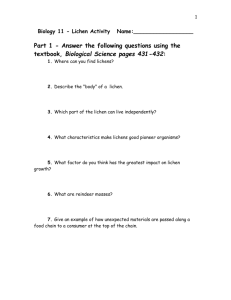WC-EM-07-05
advertisement
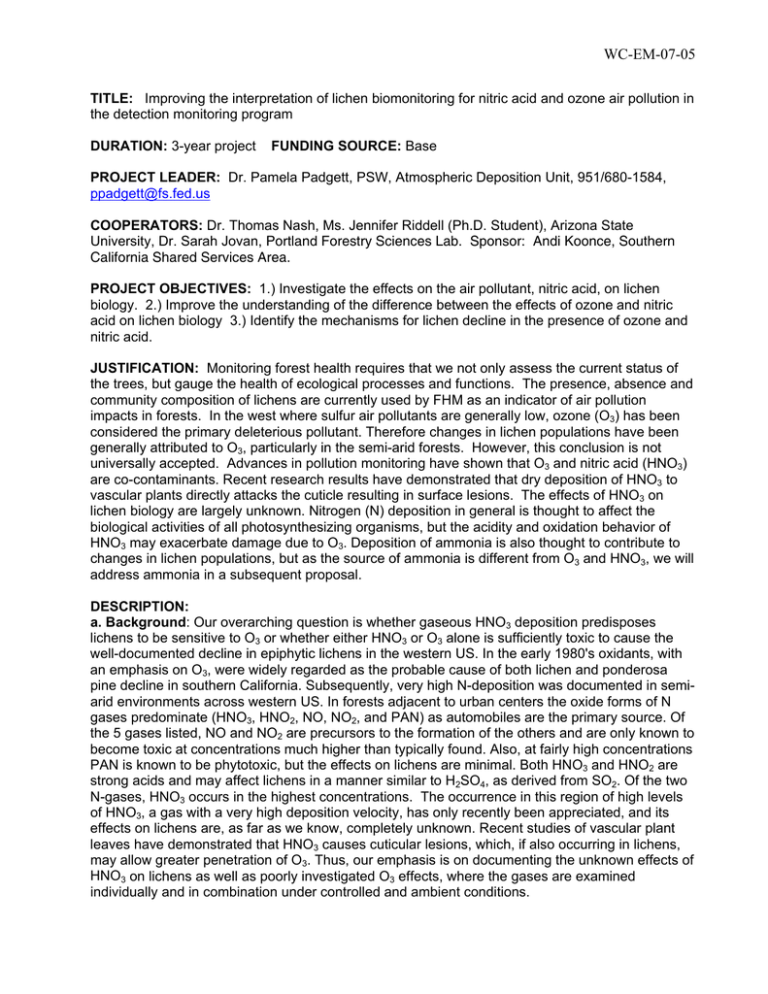
WC-EM-07-05 TITLE: Improving the interpretation of lichen biomonitoring for nitric acid and ozone air pollution in the detection monitoring program DURATION: 3-year project FUNDING SOURCE: Base PROJECT LEADER: Dr. Pamela Padgett, PSW, Atmospheric Deposition Unit, 951/680-1584, ppadgett@fs.fed.us COOPERATORS: Dr. Thomas Nash, Ms. Jennifer Riddell (Ph.D. Student), Arizona State University, Dr. Sarah Jovan, Portland Forestry Sciences Lab. Sponsor: Andi Koonce, Southern California Shared Services Area. PROJECT OBJECTIVES: 1.) Investigate the effects on the air pollutant, nitric acid, on lichen biology. 2.) Improve the understanding of the difference between the effects of ozone and nitric acid on lichen biology 3.) Identify the mechanisms for lichen decline in the presence of ozone and nitric acid. JUSTIFICATION: Monitoring forest health requires that we not only assess the current status of the trees, but gauge the health of ecological processes and functions. The presence, absence and community composition of lichens are currently used by FHM as an indicator of air pollution impacts in forests. In the west where sulfur air pollutants are generally low, ozone (O3) has been considered the primary deleterious pollutant. Therefore changes in lichen populations have been generally attributed to O3, particularly in the semi-arid forests. However, this conclusion is not universally accepted. Advances in pollution monitoring have shown that O3 and nitric acid (HNO3) are co-contaminants. Recent research results have demonstrated that dry deposition of HNO3 to vascular plants directly attacks the cuticle resulting in surface lesions. The effects of HNO3 on lichen biology are largely unknown. Nitrogen (N) deposition in general is thought to affect the biological activities of all photosynthesizing organisms, but the acidity and oxidation behavior of HNO3 may exacerbate damage due to O3. Deposition of ammonia is also thought to contribute to changes in lichen populations, but as the source of ammonia is different from O3 and HNO3, we will address ammonia in a subsequent proposal. DESCRIPTION: a. Background: Our overarching question is whether gaseous HNO3 deposition predisposes lichens to be sensitive to O3 or whether either HNO3 or O3 alone is sufficiently toxic to cause the well-documented decline in epiphytic lichens in the western US. In the early 1980's oxidants, with an emphasis on O3, were widely regarded as the probable cause of both lichen and ponderosa pine decline in southern California. Subsequently, very high N-deposition was documented in semiarid environments across western US. In forests adjacent to urban centers the oxide forms of N gases predominate (HNO3, HNO2, NO, NO2, and PAN) as automobiles are the primary source. Of the 5 gases listed, NO and NO2 are precursors to the formation of the others and are only known to become toxic at concentrations much higher than typically found. Also, at fairly high concentrations PAN is known to be phytotoxic, but the effects on lichens are minimal. Both HNO3 and HNO2 are strong acids and may affect lichens in a manner similar to H2SO4, as derived from SO2. Of the two N-gases, HNO3 occurs in the highest concentrations. The occurrence in this region of high levels of HNO3, a gas with a very high deposition velocity, has only recently been appreciated, and its effects on lichens are, as far as we know, completely unknown. Recent studies of vascular plant leaves have demonstrated that HNO3 causes cuticular lesions, which, if also occurring in lichens, may allow greater penetration of O3. Thus, our emphasis is on documenting the unknown effects of HNO3 on lichens as well as poorly investigated O3 effects, where the gases are examined individually and in combination under controlled and ambient conditions. WC-EM-07-05 Both O3 and HNO3 are secondary pollutants created by same photochemical processes from the same precursors, NO/NO2 and volatile organic carbon. Although O3 and HNO3 have natural as well as anthropogenic sources, human activity has doubled the amount of N entering the global N cycle. Ambient concentrations of O3 have increased globally from estimated background levels of 15 ppb, to more than 30 ppb. Highly polluted areas may have concentrations as high as 120 ppb. For HNO3, average 12-h atmospheric concentrations greater than 2 µg m-3 are considered significantly elevated above background. Average 12-h concentrations of 45-50 µg m-3 have been recorded in our study area. The toxicity of O3 to photosynthesizing organisms is well known; less is known about the toxicity of HNO3, although some data suggest that HNO3 may be even more deleterious than O3 under some conditions. There are virtually no data on the interaction between O3 and HNO3. Lichens as Biomonitors of Air Pollution: Lichen monitoring is an integral part of the Forest Health Monitoring Program. Just as canaries provide warnings of toxic gases to coal miners, so can the investigation of lichen communities provide information on potential deterioration of ecosystems stressed by air pollutants. Lichen species are differentially sensitive to air pollutants. The most sensitive species may become locally extirpated in urban areas or near industrial facilities, while a few very tolerant species will survive and even flourish. Except for SO2, the mechanisms underlying this differential sensitivity are poorly understood. In order to successfully understand lichen responses to a mixture of pollutants, it is critical to know to which factors lichens may be responding. In the case of southern California, we know that approximately half the epiphytic lichen species known to occur in 1913 have subsequently disappeared. Interpreting probable cause(s) is a complex exercise because different factors may be important in different locations. Are the lichens known to exhibit community variation along oxidant gradients truly responding to O3 or are they responding to some covariate, such as the HNO3 gas we know now to co-occur? Furthermore, local extirpation may simply occur with urbanization as habitats become destroyed or other factors come into play. We can never provide a complete explanation but we can make substantial progress by investigating factors, for which a major influence can be reasonably postulated. Given its extreme acidity, its very high deposition velocity relative to other air pollutants, and its comparatively high concentrations in southern California atmospheres, we believe that investigating the effects of HNO3 and its potential interaction with O3 is a logical next step in understanding the dynamics of lichen responses to air pollutants in southern California and elsewhere in the west. b. Methods: The project has 2 components; a controlled experimental laboratory fumigation study and a field transplant study in the San Gabriel Mountains east of the Los Angeles basin. Funding from FHM is requested to primarily support the field study. Resources are in place to conduct the laboratory study. The study will focus on two species, Ramalina menziesii and Hypogymnia imshaugii. Although herbarium collections indicated R. menziesii was once common in southern California, it is largely extirpated from the Los Angeles Air Basin. Hypogymnia imshaugii is a more tolerant species, and while still present, individuals are strongly bleached and contorted at highly polluted sites. Because the two lichen species differ in their apparent sensitivity to air pollution, we expect that they will differ in their intrinsic response/protection mechanisms, and, therefore, we anticipate differences between them in the extent and kinetics of the inflicted injury. Specimens of the two species will be collected from relatively pristine locations and transplanted to either the fumigation chambers in Riverside or the field site at San Dimas Experimental Forest. The fumigation studies will be used to establish the time course and the appropriate measurements for detecting damage to the exposed lichen. The Atmospheric Deposition Unit in Riverside maintains a unique air pollution fumigation facility that will enable exposure of lichens to known concentrations of O3, HNO3 independently and in combination. The fumigation system is set up to mimic outside environmental conditions including appropriate concentrations and the diurnal patterns typical of O3 and HNO3. During the exposures detailed photographs and measurements of photosynthesis, gas exchange, membrane integrity, and chlorophyll fluorescence will be taken. The data will be used to calibrate the measurements for the transplant study. WC-EM-07-05 The transplant studies will be conducted at several locations along an air pollution gradient in Southern California with a physiological sampling emphasis at the San Dimas Experimental Forest where some of the original lichen responses to air pollution studies were conducted. Ramalina menziesii and Hypogymnia imshaugii will be transplanted to appropriate substrates along the O3 and HNO3 deposition gradients previously established by the Forest Service Pacific Southwest Research Station Atmospheric Deposition Group. San Dimas has a long established active air quality monitoring system that includes monitors of ozone and nitrogen deposition, as well as monitors for wet deposition within the National Deposition Monitoring Program. We will also install N and O3 monitors at transplant sites to establish comparative data points. Previous experiments with R. mensiezii transplants in San Dimas resulted in death of the samples after 10 weeks. Because we expect a slower decline in the H. imshaugii, we will transplant both species in the beginning of the field season, and run a replicate transplant of R. mensiezii in the second 10 weeks. Samples of each transplant will be evaluated bi-weekly for the same response variables as the chamber treatments. c. Products: The main product will be an updated manual on physiological responses of lichens to O3 and HNO3. We expect the two pollutants to manifest themselves differently in the two lichen species, but if they do not – that in and of itself will be worth noting. We also expect the transplant study to guide future work on the difficulty of finding appropriate monitoring methods in extremely polluted areas such as the LA Basin. We anticipate 2 or 3 peer reviewed journal articles and presentations at professional meetings. d. Schedule of Activities: Year 1: Fumigation studies, Year 2 Field transplant studies, Year 3: Data analysis, write-up and presentations. e. Progress and accomplishments: N/A COSTS: Item Administration Salary 19.3% PSW Overhead Travel Requested from FHM Year 1 Year 2 $12,000 $12,000 $4300 $4200 $5000 $5000 Procurements $3000 Total Contracting Equipment Supplies $3000 $27,300 $5000 $26,200 Year 3 $20,000 $5000 $5000 $1000 $31,000 Other funding Source $50,000 EPA-STAR $7000 $15,000 PSW Research EPA-STAR Specific budget information: This project is the basis of a Ph.D. dissertation for Jen Riddell at Arizona State University under the guidance of Dr. Tom Nash. Ms. Riddell has received a Science To Achieve Results (STAR) fellowship from the EPA to support 2 years of her salary and funding for travel to meetings and supplies. We are requesting 9 months of her salary in the final year. The additional funding requested here will be used to enhance the project to insure that the results meet the needs of the FHM program. The Forest Service PI, Pam Padgett is providing the fumigation and laboratory facilities in Riverside and assisting with access and use of the San Dimas Experimental Forest in Southern CA. We are asking for summer salary support for Dr. Nash ($6000) and salary support for a technician to calibrate and maintain the air quality instrumentation ($6000). The project will also require substantial travel both back and forth between ASU and Riverside, and to field sites for specimen collection and managing the field experiments, which is not covered by the STAR fellowship.
